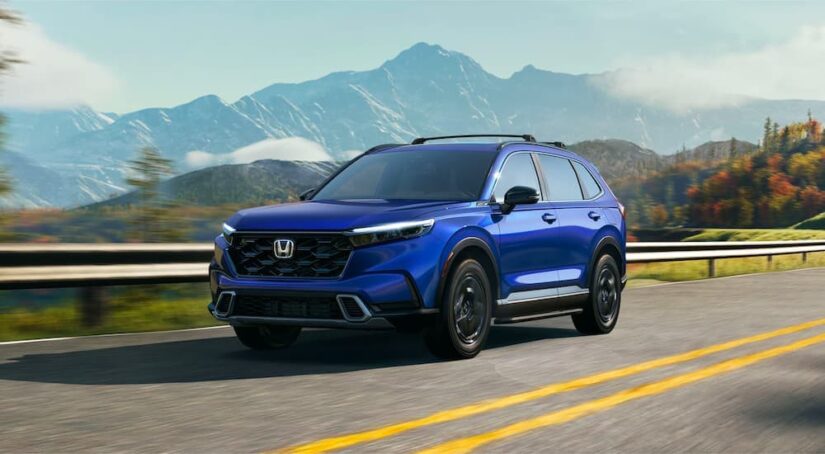“And you may find yourself behind the wheel of a large automobile. And you may ask yourself, how did I get here?” The Talking Heads could have been referring to the Honda CR-V, and how it developed from a humble compact SUV to one of the leading models in its vehicle class. Honda has already sold over 67,000 CR-V models in the first half of 2023, making it the seventh most popular passenger vehicle in America. It is also among the top three compact SUVs as well.
The 2024 Honda CR-V continues the tradition, providing a choice of a conventional gas engine or a hybrid powertrain, six different trim levels, front-wheel or Real Time all-wheel drive with Intelligent Control System, and exceptional fuel economy. In keeping with recent models, the 2024 CR-V comes equipped with standard Honda Sensing safety and driver-assist technologies, as well as the Honda infotainment system on either a seven-inch or nine-inch color touchscreen. These make the 2024 CR-V safer and more fun to drive than ever before. Let’s take a look back at how we got here with the Honda CR-V.
There’s a First Time for Everything
The folks at Honda saw the direction the automotive industry was going, with other brands embracing the move of many motorists toward SUVs. Honda took advantage of its expertise in smaller vehicles gained from years of building the Civic, specifically the Real-Time 4 Wheel Drive Civic Wagon. This enabled Honda to develop the CR-V, a compact SUV that combines the ruggedness and roominess of an SUV with the fuel economy and efficiency of the compact wagon that preceded it.
The first generation of the CR-V had a very boxy appearance, in keeping with the general look of a mid-1990s SUV. There is plenty of room in the first generation CR-V to seat up to five, while also having a roomy trunk with space for up to 67.2 cubic feet of cargo. The standard engine is a 2.0L I-4 that makes a solid 126 horsepower and 133 lb-ft of torque. The CR-V’s unibody design makes it safer and more stable, while the fully independent suspension provides a smooth ride. In addition, Honda gave a nod to other, larger SUVs by including a front skid plate on these first-generation CR-V models.
Second Time Around
Honda started a trend that it would stick to through the sixth generation, introducing the second generation of the CR-V five years after bringing the first model to the American market. The first generation CR-V was such a hit that it necessitated a second model with a number of key upgrades.
For one thing, the 2002 CR-V provides a larger trunk, giving you 33.5 cubic feet of space behind the second row of seats. This allowed drivers to move their belongings without sacrificing the three seats in the back of the vehicle. The looks also became less boxy and more aerodynamic in order to reduce wind resistance, improving acceleration and fuel economy. It also features a redesigned grille with slanted headlights and a spare tire mounted on the rear hatch.
Honda also gave the second generation a larger engine. This is a 2.4L I-4 gas engine that delivers up to 160 horsepower and 160 lb-ft of torque. Still, despite the larger engine, the second generation CR-V retains the same impressive fuel economy numbers as the first generation model because Honda gave the second generation CR-V the i-VTEC system, a form of variable valve timing that provides efficient engine performance.
Third Time’s a Charm
The third generation Honda CR-V carried over the 2.4L I-4 gas engine from the second-generation model, but Honda gave it a little kick, increasing output to 166 horsepower and 161 lb-ft of torque. The brand’s experience with smaller, efficient engines once again allowed it to do this with the 2007 CR-V without negatively impacting fuel economy numbers.
Part of the reason for this is that the third generation CR-V is more sloped than the prior model. It also contains more aerodynamic slots along its exterior, allowing for better airflow. The third generation CR-V also did away with the standard skid plate and rear-mounted spare tire from prior models. Instead, it embraced a more suburban daily driver look over the rugged SUV modeling. The CR-V also added a standard lift gate, making accessing your belongings in the trunk easier for most drivers. Honda also began offering an infotainment with a dashboard-mounted touchscreen during the third generation. This included an available built-in navigation system.
Bring Fourth the CR-V
The fourth generation Honda CR-V hit the ground running with a more aggressive grille and a stylish exterior that made it look like a smaller version of the Honda Pilot. This accounts for the 70.9 cubic feet of cargo space behind the first row of seats. Honda also gave the CR-V’s 2.4L I-4 another boost to 185 horsepower and 163 lb-ft of torque.
The interior carries over many of the improvements introduced during the second generation, such as the infotainment system called a multi-information display, and Bluetooth compatibility for hands-free calls. Honda started offering its suite of driver assistance features called Honda Sensing beginning during the fourth generation of the CR-V. However, most of these were optional equipment or required drivers to choose a higher trim level in order to get them on their vehicle. Honda also introduced an available rear-seat entertainment system to keep the kids from constantly asking, “Are we there yet?”
The Drive for Five
Starting with the 2017 Honda CR-V model, the Honda Sensing suite became standard equipment on all trim levels. This includes features like lane-keep assist, emergency braking, and adaptive cruise control. This is why the fifth generation model is one of the safest in the legacy of the CR-V.
The infotainment system on the CR-V was also improved for the fifth generation. In addition to getting a larger touchscreen, the system now also began to feature Apple CarPlay and Android Auto. This allows drivers to connect their smartphones directly to the infotainment system and stream their favorite apps.
Honda also began to offer a second engine option on the CR-V. Starting with the 2017 model, drivers could now choose a smaller, more efficient 1.5L turbocharged I-4 in addition to the 2.4-liter I-4. While the 2.4L engine was again given a boost to 184 horsepower and 180 lb-ft of torque, the 1.5L turbo engine delivers an incredible 190 horsepower and 179 lb-ft of torque, while giving you an exceptional 34 miles per gallon on the highway with front-wheel drive.
Not to be outdone, the fifth generation took a quantum leap into the future with the introduction of the hybrid model in 2020. This pairs a 2.0L Atkinson cycle I-4 gas engine with a pair of electric motors, powered by a lithium-ion battery pack. This gives the CR-V Hybrid a combined output of 212 horsepower and 232 lb-ft of torque. You also get up to 40 miles per gallon in city driving in the fifth generation CR-V Hybrid model.
The Sixth Generation and Beyond
Aside from waiting an extra year to come out with the sixth generation of the CR-V, Honda broke another tradition with this model. The 2.4L I-4 gas engine that had been the workhorse of the CR-V since the second generation in 2002 was no more. Going forward, drivers would have a choice of a 1.5L Turbo I-4 and a 2.0L I-4 Hybrid. Furthermore, the sixth generation shows that Honda is making a real push for a greener, cleaner future. More models of the CR-V are offered with the hybrid powertrain than ones with the conventional gas engine. Nevertheless, no matter which sixth generation model you choose, you are going to get exceptional fuel economy. The CR-V Hybrid will give you up to 40 miles per gallon in combined fuel economy, while a conventional gas model still gets up to 30 miles per gallon.
The sixth generation CR-V is also looking forward to the future. It has the most rugged and aggressive grille yet, offset by a pair of futuristic, slit-shaped LED headlights. Even so, the interior of the CR-V remains as spacious and comfortable as ever.
“You May Ask Yourself, Where Does That Highway Go To?”
Over six generations, the Honda CR-V has been providing drivers with comfort, convenience, fuel economy, and safety in a cutting edge compact SUV. The reason why the CR-V remains a popular best seller is because Honda remains a trendsetter in the automotive world. Just like how the Talking Heads were always one step ahead of the music world, Honda continues to be a leader with vehicles like the 2024 Honda CR-V.



